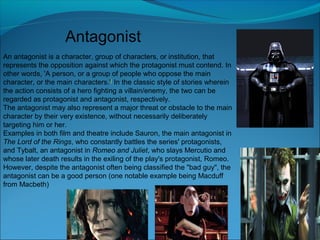
Main vs Opposing
- 1. Antagonist An antagonist is a character, group of characters, or institution, that represents the opposition against which the protagonist must contend. In other words, 'A person, or a group of people who oppose the main character, or the main characters.'[ In the classic style of stories wherein the action consists of a hero fighting a villain/enemy, the two can be regarded as protagonist and antagonist, respectively. The antagonist may also represent a major threat or obstacle to the main character by their very existence, without necessarily deliberately targeting him or her. Examples in both film and theatre include Sauron, the main antagonist in The Lord of the Rings, who constantly battles the series' protagonists, and Tybalt, an antagonist in Romeo and Juliet, who slays Mercutio and whose later death results in the exiling of the play's protagonist, Romeo. However, despite the antagonist often being classified the "bad guy", the antagonist can be a good person (one notable example being Macduff from Macbeth)
- 2. Protagonist A protagonist is the main character (the central or primary personal figure) of a literary, theatrical, cinematic, or musical narrative, which ends up in conflict because of the antagonist and with whom the audience is intended to most identify. In the theatre of Ancient Greece, three actors played all of the main dramatic roles in a tragedy; the leading role was played by the protagonist, while the other roles were played by deuteragonist and the tritagonist. The terms protagonist and main character are variously defined and, depending on the source, may denote different concepts. In fiction, the story of the protagonist may be told from the perspective of a different character (who may also, but not necessarily, be the narrator). An example would be a narrator who relates the fate of several protagonists, perhaps as prominent figures recalled in a biographical perspective. Often, the protagonist in a narrative is also the same person as the focal character, though the two terms are distinct. Excitement and intrigue alone is what the audience feels toward a focal character, while a sense of empathy about the character's objectives and emotions is what the audience feels toward the protagonist. Although the protagonist is often referred to as the "good guy", it is entirely possible for a story's protagonist to be the clear villain, or antihero, of the piece. The principal opponent of the protagonist is a character known as the antagonist, who represents or creates obstacles that the protagonist must overcome. As with protagonists, there may be more than one antagonist in a story. The antagonist may be the story's hero; for example, where the protagonist is a criminal, the antagonist could be a law enforcement agent that tries to capture him. Sometimes, a work will offer a particular character as the